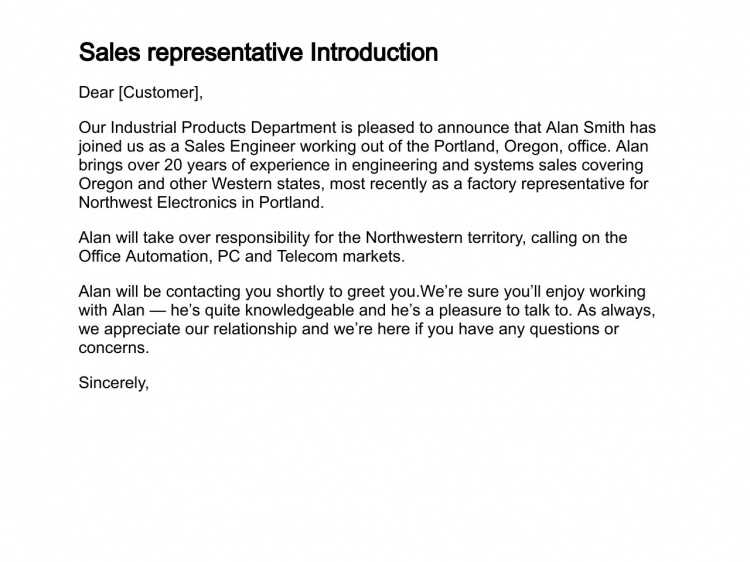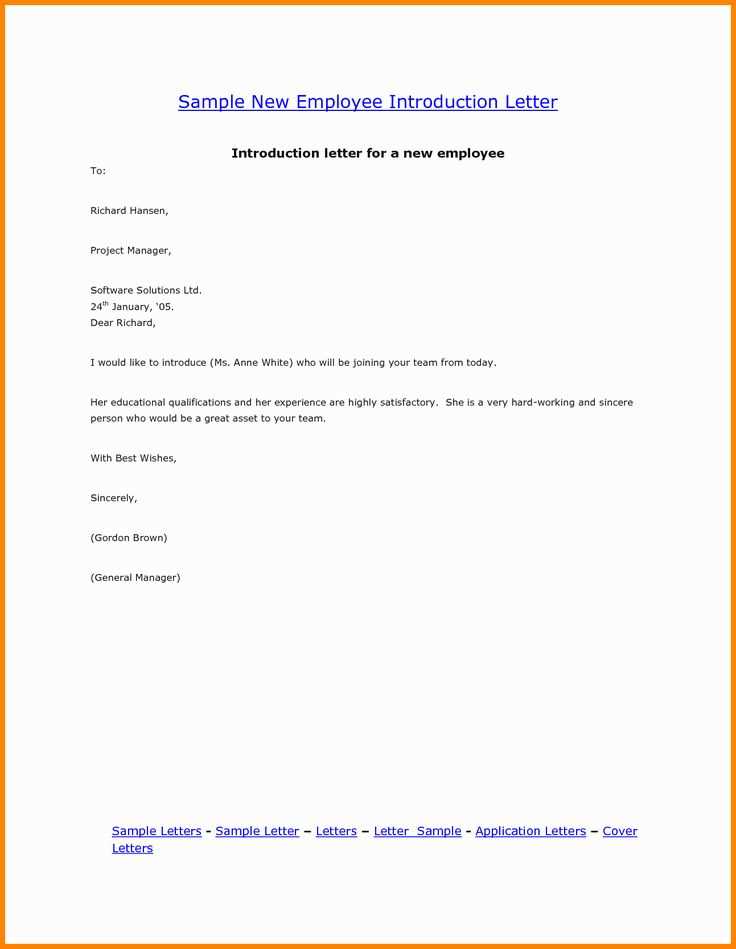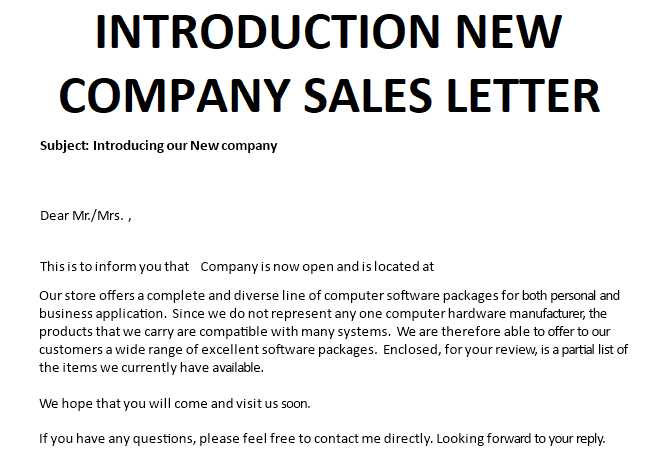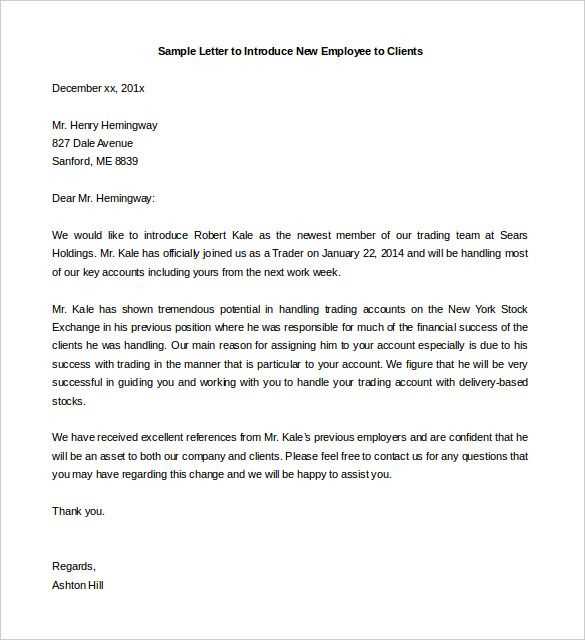Effective Product Introduction Letter Template for Success

When reaching out to potential clients or partners, a well-crafted message is essential for conveying the value of what you offer. This first step sets the tone for future interactions and establishes a strong foundation for your business relationship. Whether you’re launching a new service or presenting an innovative item, making a great first impression is key.
Clarity and engagement are crucial when conveying your message. The goal is not only to inform but also to captivate your audience, making them eager to explore more. A well-structured communication can significantly improve the likelihood of a positive response and further discussions.
By following best practices in structuring your message, you can ensure that every word serves a purpose and leaves a lasting impact. Clear and concise language, along with a personalized touch, can help you stand out and effectively present your offerings to the right people.
Key Elements of a Successful Product Letter
Crafting a compelling message requires careful attention to structure and content. A strong communication should be clear, concise, and targeted to resonate with the audience. Ensuring that each element of your message serves a specific purpose will increase the chances of engaging your recipients and achieving the desired outcome.
First, a clear and relevant subject line grabs attention immediately, enticing the reader to explore the content further. Follow this with a brief and direct introduction that establishes who you are and why the recipient should care. It’s important to quickly convey the value or benefit your offering brings.
Additionally, the body of the message should include a succinct description of your offering, focusing on its unique features or advantages. Avoid unnecessary details and instead highlight how it can solve a problem or meet a specific need for the recipient.
Lastly, a strong call to action at the end encourages the reader to take the next step, whether it’s scheduling a meeting, making an inquiry, or exploring more information. By maintaining a balance of professionalism and personalization, your message can leave a lasting impact.
How to Craft a Strong Opening
The opening of your message plays a crucial role in setting the tone for the rest of the communication. A strong start grabs the reader’s attention and motivates them to continue reading. The key is to strike a balance between being professional, engaging, and clear about the purpose of your message from the very beginning.
Key Strategies for a Strong Start

- Personalization: Address the recipient by name or reference something specific about their company to make your message feel tailored and relevant.
- Hook: Begin with a compelling statement or question that piques curiosity and makes the recipient want to learn more.
- Value Proposition: Clearly state how your offering can benefit the recipient, highlighting what sets it apart from other options.
Examples of Effective Openings

- “I noticed your recent expansion into the European market and believe our solution can help streamline your operations.”
- “After reviewing your current challenges with [specific issue], I’m confident that our new offering can provide the perfect solution.”
By focusing on personalization and immediately demonstrating value, you increase the chances of engaging your recipient and encouraging further interaction. A strong opening can make all the difference in ensuring your message is read and acted upon.
Common Mistakes to Avoid in Letters
Even the most well-intentioned communication can fail if it contains common errors that undermine its effectiveness. Small mistakes can lead to misunderstandings or even lost opportunities. Understanding what to avoid ensures your message remains clear, professional, and impactful.
- Overloading with Information: Including too many details can overwhelm the reader. Focus on the key points that matter most and keep your message concise.
- Lack of Personalization: Sending generic, impersonal messages can make the recipient feel like just another contact. Personalize the content to show that you understand their unique needs.
- Unclear Call to Action: If your recipient doesn’t know what to do next, your communication loses its purpose. Always provide a clear, actionable next step.
- Excessive Formality: Being overly formal can come off as distant or robotic. A balance between professionalism and approachability works best.
- Ignoring the Recipient’s Needs: Tailor the message to show how your offering specifically addresses the recipient’s challenges or goals. Failing to do so makes the message feel irrelevant.
Avoiding these common mistakes ensures your communication remains clear, engaging, and relevant, increasing the chances of a positive response. By refining your approach, you can make a stronger impact with every message you send.
Best Practices for a Clear Message

Delivering a clear and concise message is essential for effective communication. When your recipient quickly understands the purpose of your message and its relevance, they are more likely to engage and respond positively. To ensure clarity, focus on structure, language, and the core message you want to convey.
- Keep It Simple: Avoid complex language and jargon. Use straightforward, easy-to-understand words that resonate with your audience.
- Be Direct: Clearly state your intent from the beginning. Let the reader know exactly what you’re offering and how it benefits them.
- Organize Your Content: Break up your message into easily digestible sections. Use bullet points, short paragraphs, and headings to guide the reader.
- Focus on One Key Point: Don’t overwhelm your audience with multiple messages. Stick to one main idea to keep the communication focused and impactful.
- Use Active Voice: An active voice makes your message more engaging and easier to follow. It also sounds more confident and direct.
By implementing these best practices, you ensure that your communication is not only clear but also engaging. A well-structured and simple message can significantly increase the likelihood of a positive outcome.